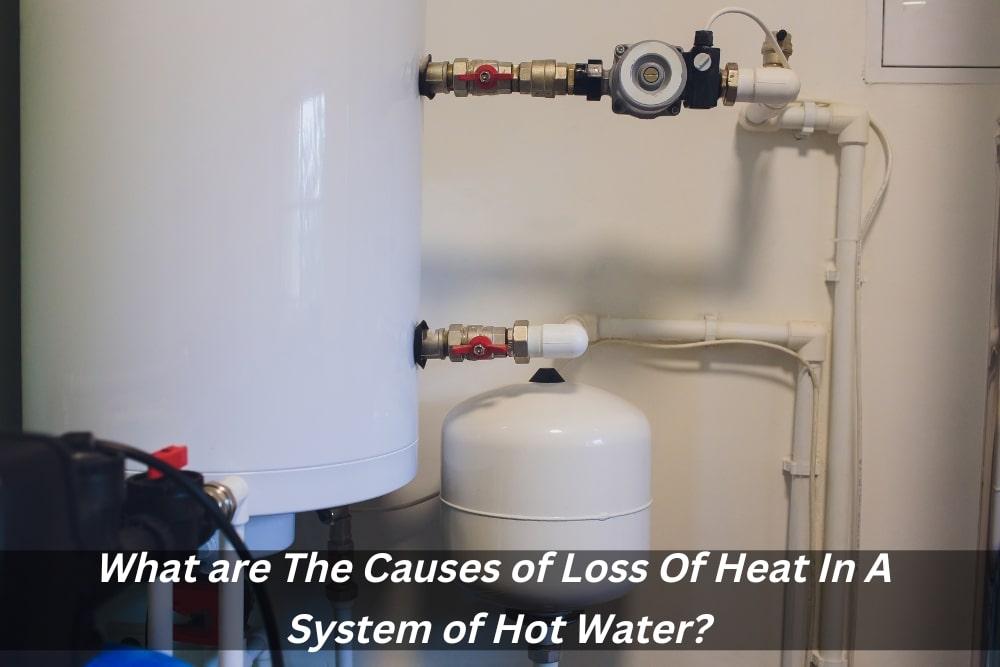If you have ever been surprised by a cold shower, you may have wondered what causes the loss of heat in hot water systems. Contrary to popular belief, it is not simply due to the water cooling as it travels through the pipes. In this article, we will explore What causes loss of heat in a hot water system.
There are many potential causes of heat loss in hot water systems. Hot water systems are complex and require regular maintenance to ensure optimal performance. Some of the most common causes of heat loss include:
1. Loss of Heat
When using hot water systems, some amount of heat will be lost to the environment. This could mean that hot water isn’t as hot as you expect it to be after being heated. If you’ve been experiencing problems with cold showers or hot water not staying warm enough, then you know about the loss of heat.
In addition, loss of heat may occur if your hot water heater doesn’t have enough capacity to provide hot water at higher temperatures. You should check your hot water temperature regularly and try to keep it between 120°F and 130°F (49°C-55°C).
2. Insulation
Your home’s insulation should help protect your hot water from losing its heat to the outside. However, it can increase the loss of heat. If your hot water pipes are laid directly above or under heating ducts, they will lose more heat than pipes laid on top of each other. Make sure that any piping near heating ducts is insulated.
3. Leaks
Leaking connections inside your home can cause air leakage and allow cold air to enter your hot water pipes. There is no need to worry about leaks around faucets. Instead, check the baseboard joints and behind appliances to make sure they are sealed properly. In addition, look at the backside of the radiators and check the bottom of the sinks and tubs to ensure proper sealing.
4. Hot Water Tank
If your hot water tank is set too low, it can result in the water not being hot enough when it reaches your faucets or shower. The thermostat on your hot water heater should be set to at least 120°F (49°C). In addition,
If your hot water tank is located in an unheated space, such as a garage or basement, it can cause the water to cool down too much before it ever reaches your taps.
5. Hot Water Usage
If you are using a lot of hot water in a short period of time, it can lead to a loss of heat in the system. This is because the hot water has to travel through more piping to reach all of the fixtures in your home.
Several factors can cause heat loss in a hot water system. By taking the time to troubleshoot the problem, you can prevent further heat loss and save money on your energy bill.
What are the different types of heat loss in a hot water system?
There are three main types of heat loss in hot water systems: conduction, convection, and radiation. Each type of heat loss has its unique characteristics and occurs in different ways.
Conduction
Conduction is the transfer of heat from one molecule to another through direct contact. In a hot water system, conduction occurs when heat moves from the hotter water molecules in the system to the cooler surrounding air. This type of heat loss is most common in systems that have exposed piping, such as those that are mounted on an exterior wall.
Convection
Convection is the transfer of heat through the movement of fluids or gases. In a hot water system, convection occurs when heated water rises and cooler water takes its place. This type of heat loss is most common in systems that have closed piping, such as those that are buried in the ground.
Radiation
Radiation is the transfer of heat through electromagnetic waves. In a hot water system, radiation occurs when heat moves from the hotter water molecules in the system to the cooler surrounding air. This type of heat loss is most common in systems that have exposed piping, such as those that are mounted on an exterior wall.
Ways to prevent or minimise heat loss in hot water

Hot water systems are a common source of energy loss in many homes. There are several ways to prevent or minimise heat loss from hot water systems.
One way to prevent heat loss is to insulate the hot water tank and pipes. This can be done with special blankets or wraps that are available at most hardware stores.
Another way to reduce heat loss is to install low-flow showerheads and faucet aerators. These devices help to reduce the amount of water that is lost through evaporation and also help to conserve energy.
Check for leaks regularly and repair them as soon as possible. Even a small leak can cause a significant amount of heat loss.
Another way to keep Hot Water Systems Hot is by turning the temperature down on the thermostat. By turning the temperature down, you will use less energy overall and save money on your utility bills.
Hot water systems are typically set to 140 degrees Fahrenheit, but lowering the temperature to 120 degrees can save significant amounts of energy.
If you have an older hot water system, it may be time for an upgrade. Newer hot water systems are much more efficient than older models and can help significantly reduce your energy costs.
Following these tips can help you prevent or minimise heat loss from your hot water system. By taking these measures, you can improve the efficiency of your system and save money on your energy bills.
How does insulation help to prevent heat loss in a hot water system?
As most homeowners know, hot water systems are a key component to having a comfortable home. Hot water is necessary for cooking, cleaning, and bathing. Hot water system insulation helps to prevent heat loss in the system, ensuring that your home has the hot water it needs when you need it.
There are three main types of insulation that can be used on hot water systems: fibreglass, foam, and pipe wrap. Each type of insulation has its own benefits and drawbacks, so it is important to choose the right type of insulation for your particular system.
Fibreglass
Fibreglass is the most common type of insulation used on hot water systems. It is inexpensive and easy to install. Fibreglass is also effective at preventing heat loss. However, fibreglass is not as durable as other types of insulation and can be damaged easily.
Foam insulation
The foam insulation is more expensive than fibreglass, but it is also more durable. Foam insulation is also effective at preventing heat loss. However, foam insulation can be difficult to install and is not as widely available as fibreglass.
Pipe wrap
Pipe wrap is the most durable type of insulation. It is also effective at preventing heat loss. Pipe wrap is more expensive than fibreglass and foam, but it is easier to install. Pipe wrap is also less likely to be damaged than other types of insulation.
When choosing insulation for your hot water system, it is important to consider the climate in which you live. If you live in an area with extreme temperatures, you will need to choose insulation that can withstand extreme heat or cold. You should also consider the type of hot water system you have. Some hot water systems are more sensitive to heat loss than others.
If you are not sure which type of insulation is right for your hot water system, you should consult a professional to help you choose the right type of insulation for your system and climate.


